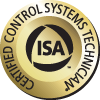- CCST
Summary


CCST question
Which of the following valve actuation methods would be the best choice for an application that requires a very large force and a small actuator?
A. pneumatic actuation
B. hydraulic actuation
C. manual actuation
D. electrical actuation
CCST Answer
The correct answer is B, hydraulic actuation. Although many pneumatic actuators can provide a large force, they require either a large diaphragm area (in the case of a diaphragm actuator) or a large cylinder (in the case of a rack and pinion actuator).
Hydraulic actuators are driven by a high-pressure fluid (up to 4,000 psig) that can be delivered to the actuator by a pump that is remote from the actuator itself. Hydraulic cylinders can deliver up to 25 times more force than a pneumatic cylinder of the same size.
Manual actuation is accomplished by turning a valve handle, and is limited to the amount of force that an operator can exert on the lever or hand wheel.
Electric actuation delivers high torques for rotary-style valves, but electric actuators tend to be large and heavy compared to hydraulic actuators.
Reference: Goettsche, L.D. (Editor), Maintenance of Instruments and Systems, Second Edition, ISA, 2005.
Reader Feedback
We want to hear from you! Please send us your comments and questions about this topic to InTechmagazine@isa.org.
